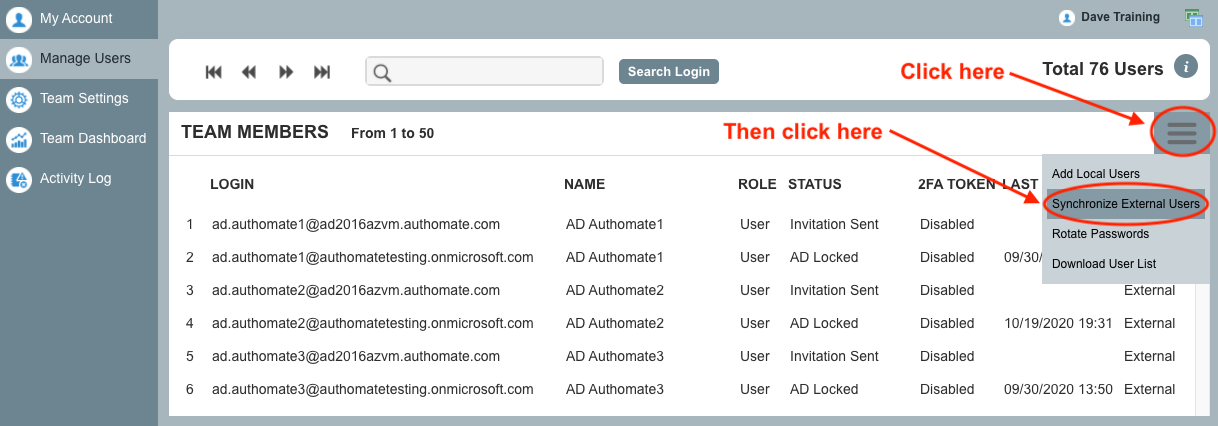There are two types of user accounts for Authomate Teams:
- Local User accounts are created and authenticated locally on the Authomate Server.
- External User accounts are created and authenticated with an external directory service such as LDAP/Active Directory or Azure AD.
Local User Accounts
1) Log into your Authomate website account from the sign in page and go to Manage Users. Click on the menu icon and select Add Local Users.
2) This starts the Add New User Accounts Wizard which gives you the choice of adding a single user or importing a list of users from a file.
To add a single user, click on the Add One Account button. Fill in the form with the user's display name and email, and set the number of days they have to respond to the email invitation to join the team:

To import a list of users, create a text file with each line containing the user's display name and email address separated by a comma or tab. Click on the Import From File button and follow the prompts to upload the file and review the imported list. If the file contains format errors, they will be highlighted in yellow. Hover your mouse over the highlighted field for more details. Correct the errors in the file, then click "PREVIOUS" to go back and re-import the file.

3) The Authomate server will send an email invitation to each user with instructions on how to join your team.
External User Accounts (LDAP/ActiveDirectory/Azure AD)

2) It may take some time to query the external directory server so the Authomate server keeps a cached list from the last query. If it has been more than 15 minutes since that last query, you will be prompted to refresh the cached list.

3) The Returned in Query tab lists the users returned by the query parameters specified in your External Directory Service team settings. For LDAP/Active Directory these are users that match the Search For and Query Root fields, and for Azure AD these are users that are members of the group or list of groups in the Groups field. Each user is identified with one of the following icons:
 | Synchronized | User is a member of your team. Email and Name fields match values in the external server |
 | Not A Team Member | User is not a member of your team |
 | Not Synchronized | User is a member of your team but Email and/or Name fields do not match values in the external server |
The buttons at the top of the screen are:
| Refresh | The Refresh button will re-run the query |
| Full Sync | The Full Sync button will:
|

4) To add new team members from the external directory service, click on the Not A Team Member tab. Select users, then click the Add Checked Users To Team button. The Authomate server will send an email invitation to each user with instructions on how to join your team. If a user does not have an email address defined in the Active Directory, the team administrator should instruct the user to go to the sign in page and log into their Authomate website account with their AD login and password, then follow the Add/Replace procedure to register their phone.

5) The Not in External User Query tab lists external users that are currently in your team but are no longer returned in the query. If you have auto sync enabled in the team settings, these team members will be locked (if they are not already locked) the next time auto sync runs (evening Eastern Standard Time). If you would like to delete any of these users from the team, select them, then click the Delete Checked Users From Team button.

6) The Not Synchronized tab lists the users where the name or email differs between Authomate server and external server. Select users, then click the Update Checked Users button to update the values of team fields with the displayed values that are currently on the external server.

